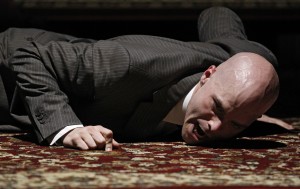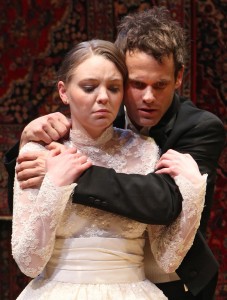Many of Off Off Broadway’s most successful companies present their work in a heightened theatrical acting style, which seems to be poking fun at the entire dramatic enterprise from the Greeks to Law and Order. It has become a rarity to see a play in which high dramatic acting is performed in earnest. As if calling on the spirits of the ancient actors who first got on a stage to perform, or on the practitioners in far corners of the globe who still perform their ancient methods today, Rabbit Hole Ensemble valiantly goes there. In so doing the company sheds some light on why that kind of acting is shied away from by virtually every living western theater director. One of the best moments in Doctor Frankenstein's Magical Creature is entering the space. A large room inside the Old First Reformed Church on Carroll Street in Park Slope is sparsely, elegantly set up. One long, curved row of chairs is book-ended by an actor on each side. In front of them sits a cloth with several objects sitting on it: a drum, a pistol, and more. When the lights go down on the audience the only light in the room is that coming in from the decorated church windows high above the stage. One of the two actors who were sitting with us picks up a light fixture and flashes it on the narrator’s face. These simple, hand held lights are the only ones we will encounter all evening.
In that spooky bottom lighting, as if we’re all seated around a bonfire, Emily Hartford begins telling the story of Frankenstein, through the voice of the (female in this production) creature, not the (female) doctor. The story-telling is enhanced by effective work from the ensemble, which surrounds the audience with sound, physically acts out the narration, and handles the seamless motion of the simple and pretty lighting design (by director Edward Elefterion). The haunting story, however, quickly becomes something akin to a Greek tragedy, in which we watch the creature (Jocelyn O'Neil) grow from a sad but hopeful, peaceful being into a vengeful murderer.
The production works with Rabbit Hole’s signature minimalist aesthetic, focusing the piece on the physical abilities of the actors. Director Elefterion handles the ensemble well, but his insistence on relating the acting style to a more grandiose form of drama, such as Japenese Noh, is the play’s downfall. While some of the actors seem uncomfortable sustaining this heightened style, perhaps the main reason it turns flat less than halfway through the (under an hour) evening is the seriousness with which the production seems to take itself. It is a gravity which does not translate into an emotional experience for the audience. Instead it comes across as self-conscious and slight, and leaves the spectators disconnected.
The script has strong moments, especially early on as writer Stanton Wood connects us with the emotional landscape of the creature. However, the play tries to be something akin to a classical tragedy with very little of the tool classical plays utilize most, dialogue. Adding to this is the way in which this rather intellectual piece occasionally slips into tiring cliché, as when the creature despairs: “I just want to be accepted.”
It’s refreshing to see a company be straightforward about the drama it is creating. But the dramatic has already been abducted by bad television, leaving theater artists with a burning need to re-invent it. Successfully plowing ahead with “drama” as if it hasn’t changed in 3000 years, even if you are adding some contemporary touches, would require an act of genius. Even the Greeks are performed small these days.








